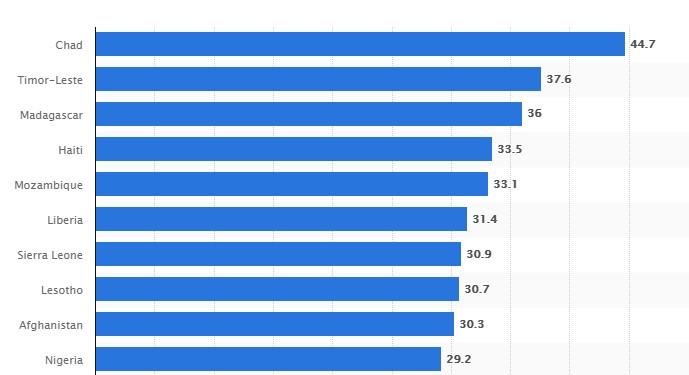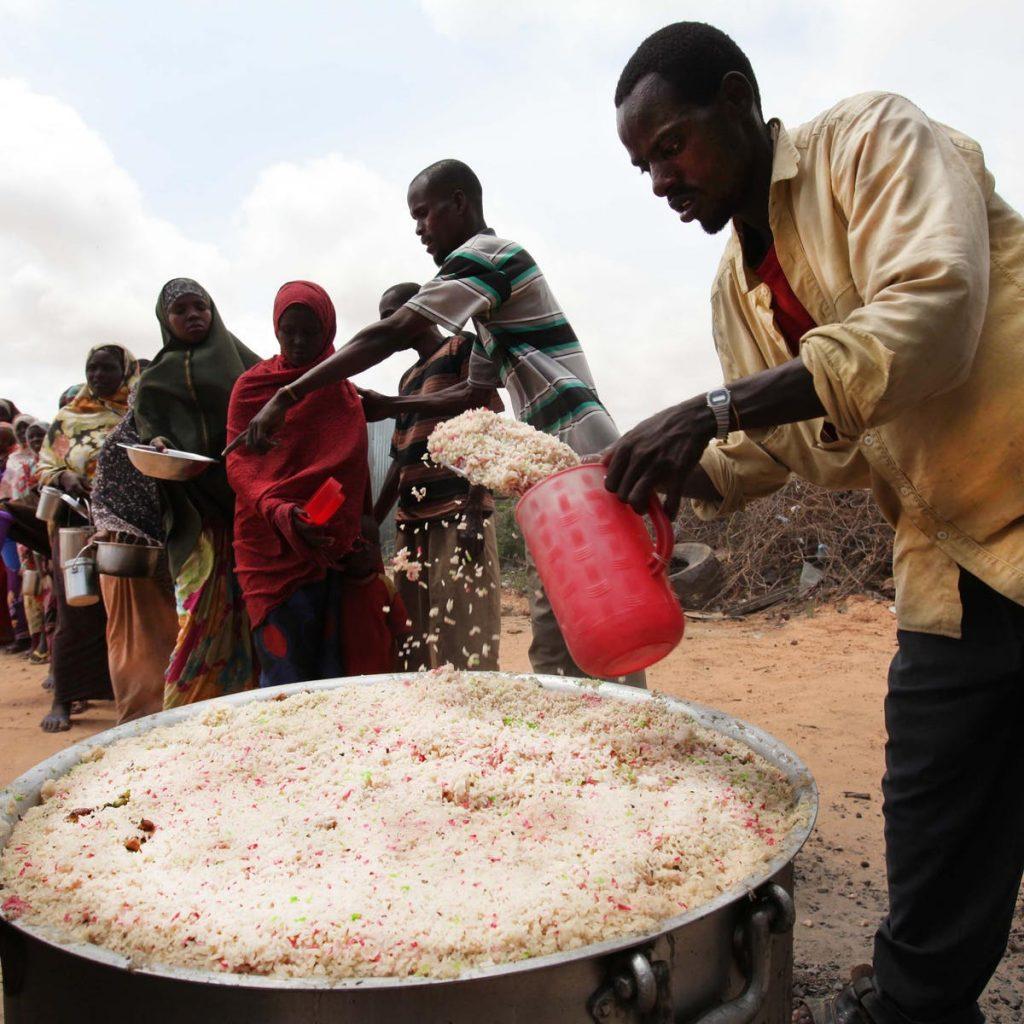United Nations Sustainable Development Goal 2 aims to ensure no person goes hungry by 2030. To achieve this, we will need to address food security, improved nutrition, and sustainable agriculture. However, the UN Food and Agriculture Organisation found that nearly 690 million people, or 8.9 per cent of the world suffers from hunger. As a result, the world is NOT on track to achieve Zero Hunger by 2030.
Africa and South Asia account for the highest number of people who go hungry on a daily basis. Despite this, there are reasons for hope as the level of hunger in the world has decreased by 27% between 2000 and 2017.
According to the Global Hunger Index, the 10 countries most affected by hunger in 2020 were.

Top ten causes of world hunger:
According to Concern Worldwide, there are ten main causes of hunger.
- Poverty: Poverty and hunger exist in a vicious cycle. Malnutrition leads to underdevelopment, lack of abilities and unemployment.
- Food shortages: Droughts or disease-carrying organisms and pests can lead to crop failures, often causing food shortages.
- War and conflict: These are among the leading contributors to world hunger. They cause population displacement and lack of access to food sources and production.
- Climate change: With extreme climatic events, crops fail drastically. This factor has the potential to drive a hundred million people into poverty.
- Poor nutrition: Without a variety of food sources for adequate nutrition human health suffers.
- Poor public policy: A country’s poor infrastructure and lack of investments in agriculture can lead to extreme poverty and hunger.
- Economy: A country’s economic resilience and stability has a direct effect on its nutritional resilience. Working towards economic stability has a ripple effect on all the items in this list.
- Food waste: Lack of food storage or poor distribution can cause this. As a result, food, and other valuable resources such as water and soil are wasted.
- Gender inequality: Female farmers are often responsible for many agricultural activities, and food production in poor countries. Despite this, they tend to be underrepresented at decision making forums.
- Forced migration: Refugees fleeing conflict often live in areas with inadequate food supply. Droughts in their homelands also add to this.
Hunger is not caused by scarcity
As seen above, the hunger problem is not simple. For instance, in 2012, Holt-Giménez et al. found that there is enough food to feed 1.5 times the size of the world population. However, most industrially-produced grain crops go to biofuels, (to power vehicles), and confined animal feedlots rather than people. Furthermore, they found that hunger is due to poverty and inequality, not scarcity.

Why are people poor? Why isn’t food distributed equally throughout society? The reasons can vary but are mainly in the political and economic spheres. When looking at a deeper level, the root cause of hunger is often social injustice.
Effects of world hunger
Hunger is a major source of stress, disease and underdevelopment in a society. An individual deprived of food cannot lead a healthy and productive life. For example, the World Health Organization found that in 2020, 149 million children under five were estimated to be stunted (too short for age). Additionally, 45 million were estimated to be wasted (too thin for height).
Research in the USA has shown that hunger causes delayed development in young children. It also increases the chance of behavioural problems appearing in school-age children, such as hyperactivity, anxiety and aggression.
Hunger can also lead to violence, as individuals fight for food to survive. In this respect, we can expect more conflict due to climate change harming food security in the world.
How can we achieve Zero hunger?
A popular proverb says that “If you give a hungry man a fish, you feed him for a day, but if you teach him how to fish, you feed him for a lifetime”. Therefore, similar approaches should be taken in efforts to combat and achieve zero hunger. However, in disasters and emergencies, food must be distributed freely, quickly and effectively.
Grow your own food
Cities and municipal councils can encourage backyard and community vegetable gardens. Alternatively, if there is not enough produce, charities and governments agencies can support diets with food stocks. Urban farming is a growing trend as shown in this THRIVE blog post.
Support the charities
Countless charities and food banks are gathering resources to feed the poor. Hence, genuine organisations need support and donations to continue their work. For example, in 2020 the USA organisation Feeding America distributed free food for 43 million people in need.
Be mindful of waste
According to the UN Food and Agriculture Organisation, an estimated 1.3 billion tonnes of food is wasted globally each year. Not throwing food out will help those in need, as excess food can be sent to food banks or be sold at discounted prices.

Support the World Food Program
The World Food Program has several mechanisms in place. Many of these use smart technologies to feed refugees and those who are in need. These vary from using hydroponics to grow food in refugee camps, to using smart cards to let those in need buy food. To support the program, rich countries should contribute to the Committee on World Food Security.
Distribute food in areas of conflict
Food distribution networks are often not efficient enough to reach the needy. One example is conflict, which often prevents United Nations ration trucks from arriving to those in need. For instance, among the millions of people suffering from chronic malnutrition in 2016, 60 per cent lived in areas affected by armed conflict. Therefore, refugee camps should be prioritised when giving out food aid. In addition, people should engage in campaigns that aim to feed refugees.

Promote Social Justice
The NGO Whyhunger advocates the growth of social justice grassroots movements to provide the basic human right of food. To achieve this, we need to address the root causes of hunger. These include poverty, racism, sexism, classism, homophobia, and other forms of oppression. One way of enabling social justice is by fostering supportive partnerships rooted in trust and solidarity, and committing to building the capacities of local leaders.
Seek alternatives to industrial agriculture
The Green Revolution started in the 1940s in Mexico and the 1960s in India. It used science and technology to increase yields of grain crops. This succeeded in reducing famine at the time. Despite this, it has received criticism, as it often comes at the expense of the natural environment. This is mainly because machines and pesticides rely heavily on fossil fuels. Additionally, large agribusinesses often take over vast areas of land for industrial agriculture, rarely cater for the poor and often offer poor quality diets.
To produce food with enough variety to sustain ourselves, solutions should include small-scale agriculture. It involves working in small plots to allow a more balanced and productive system. This is referred to as agroecology, and includes organic agriculture and permaculture.
The following short YouTube video explains the details of Agroecology. Source: iPES Food
Why agroecology instead of Industrial agriculture?
Critics of agroecology and organic agriculture claim that they use twice the area for the same yield. However, a study by the Rodale Institute of Regenerative Agriculture, Pennsylvania, USA, has dismissed this assumption. They found that the yield gap is not as wide. Furthermore, there are many advantages in terms of sustainability. Australian Indigenous peoples, as described by a book by Bruce Pascoe, often used these principles to live in a dry continent for thousands of years until white colonisation arrived in the late 1700s. Although prone to criticism, Pascoe’s book can be a valuable source of information for changing the way we produce food more sustainably.

Where to go from here?
We need to adopt the solutions outlined above to help us to achieve Zero Hunger. In addition, there are many opportunities to help the poor, often as a volunteer in your city or abroad.
Undoubtedly, the discussion of world famine must include politics. Political systems create economic systems, which in turn drive food production activities. Often, poor workers displaced by large agribusinesses through labour replacing technologies often end up in large cities. This usually leads to more hungry people in urban areas.
To meet the challenges described, agroecological approaches and structural reforms are necessary. This will ensure that resource-poor farmers have the land and resources they need to live sustainably, creating a world where more human beings can THRIVE free from hunger. To this end, you can work in many countries as a WWOOFer (Willing Worker in an Organic Farm) helping to produce wholesome food.
For a perspective of what future agriculture has in store, please refer to THRIVE’s blog articles about the future of farming and remote sensing in modern agriculture. Otherwise, you could join the THRIVE Project and help create a world free from inequality, poverty and hunger.
Great read Sinval. One of my pet peeves is seeing how much food gets wasted. I think we waste approximately 1/3 of the food we produce. Also, an interesting idea you posited with agroecology. Going to have to look that one up.
Comments are closed.